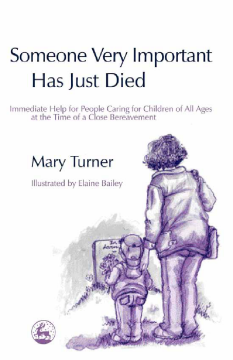
Additional Information
Book Details
Abstract
When a family member or close friend dies, it can be difficult to know how best to help the children and teenagers involved. Someone Very Important Has Just Died is a practical book written for those caring for children and teenagers suffering a close bereavement. Intended for use immediately or soon after the death has occurred, this book gives practical and detailed guidance on what adults might say and do to help children.
This much-needed resource tackles the sensitive issues of what to tell children, how far to include them in the events immediately after the death, and how to tend to their physical and emotional needs. The material is suitable for anyone regardless of their background and beliefs, and is supplemented with information on where to go to obtain longer term bereavement support.
Someone Very Important Has Just Died is an ideal resource for professionals in all areas of work relating to bereavement. It is designed to be given to adults with children in their care at the time of a death.
Mary Turner is a counsellor and psychotherapist. She has considerable experience working with grieving children and families in social service, hospital, hospice and bereavement service settings. She teaches on university palliative care courses and is author of Talking with Children and Young People about Death and Dying, also published by Jessica Kingsley Publishers. Elaine Bailey is a freelance illustrator.
Table of Contents
| Section Title | Page | Action | Price |
|---|---|---|---|
| Acknowledgements v | |||
| List of Tables and Figures ix | |||
| List of Diagrams X | |||
| Introduction 1 | |||
| PART I: PONDS, PROTEIN AND THE POOR 7 | |||
| Chapter 1: Aquaculture in Bangladesh 9 | |||
| The setting: rural Bangladesh 9 | |||
| Fisheries in Bangladesh 20 | |||
| Aquaculture 23 | |||
| The region 27 | |||
| The study methodology 28 | |||
| Organization of the material 30 | |||
| Chapter 2: Markets, entrepreneurs and intervention 33 | |||
| Introduction: the policy context 33 | |||
| Aquaculture: state, market and community 35 | |||
| Rural markets 36 | |||
| Aquaculture markets - 41 | |||
| Entrepreneurship and innovation 43 | |||
| Intervention issues ' 46 | |||
| PART II: THE FISH TRADING NETWORK-TRAINS; | |||
| BUSES AND RICKSHAWS 51 | |||
| Introduction: an overview of the trading system 53 | |||
| Chapter 3: Finding the silver seed 55 | |||
| Wild hatchling collection 55 | |||
| Hatchery production 60 | |||
| Fingerling production 64 | |||
| Chapter 4: Wholesalers at the station 71 | |||
| The station market 71 | |||
| Chapter 5: Into the rural hinterland 77 | |||
| Fingerling traders and transportation 77 | |||
| Management of food fish ponds 86 | |||
| Chapter 6: Netting the catch 93 | |||
| The decline of traditional fisherfolk 93 | |||
| Food fish markets and traders 101 | |||
| PART III: POVERTY, MARKETS AND PROJECTS 113 | |||
| Chapter 7: Risky transactions 115 | |||
| The power of knowledge 115 | |||
| Risk management 117 | |||
| Credit, prices and profits 120 | |||
| Interlocked markets 124 | |||
| Chapter 8: Social preconditions of markets-the test | |||
| case of cultured fish 127 | |||
| Aquaculture and agrarian structure 127 | |||
| Markets, trust and morality 131 | |||
| The absence of formal law 136 | |||
| Winners and losers 143 | |||
| Chapter 9: Improving opportunities for the poor 147 | |||
| Possibilities considered 147 | |||
| 'Off the page and into the pond' 153 | |||
| 'Indigenizing' extension: the extension trader experiment 154 | |||
| Appendices | |||
| 1 Wild hatchling collection 167 | |||
| 2 The hypophysation process 168 | |||
| 3 Techniques of fingerling transportation 169 | |||
| 4 Water quality in the carrying vessels 173 | |||
| 5 Station trading data (seasonal distribution by species) 176 | |||
| 6 Price data 181 | |||
| Glossary 185 | |||
| Specialist terms 187 | |||
| Bibliography 189 | |||
| Index 195 |
